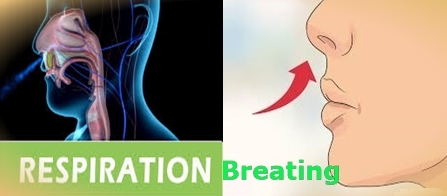Differences between Respiration and Breathing

Differences between Respiration and Breathing
Respiratory system is one of the main systems of human body without which there is no chance of survival. In humans respiratory system is divided into ‘upper and lower’ respiratory tracts. Upper respiratory tract consists of nose, sinuses, larynx, pharynx and vocal cords. Lower respiratory tract consists of trachea, bronchi and bronchioles. Upper respiratory tracts serve the function of transferring air to lower respiratory tract where gases are exchanged at the level of lungs. The breathing rate of a normal person is 10-14 times per minute. Number of diseases change anatomy of respiratory system thus disturbing physiological processes of breathing and respiration. Following article highlights major differences between the two processes.
Respiration
This process starts when the air enter the nostrils and mouth. It then travels through the larynx and trachea and finally reaches at the level of lungs. Lungs have numerous small sac-shaped structures with thin walls which allow exchange of gases across the. At the alveolar level, oxygen is transferred from fresh air to the small blood vessels which are located near alveoli. This blood is then taken to the heart which distributes it to body tissues. End product of oxygen consumption i.e. carbon dioxide is diffused to blood at cellular level and is taken back to lungs from where it is exhaled.
Breathing
Breathing process consists of two steps i.e. inhalation and exhalation. During inspiration, rib muscles contract, ribs are raised and diaphragm which is a muscle under lungs is contracted. Combination of these changes allows the rush of air from outside to the lungs. During expiration, rib muscles relax, ribs get back to original position and diaphragm relaxes. Various diseases of breathing system incorporate bronchitis, emphysema, pneumonia, asthma and cancer.
Respiration VS Breathing
Process:
Respiration is purely a chemical process.
Breathing is a physiological process.
Function:
Respiration allows gaseous exchange at cellular level.
Breathing allows inspiration of pure air and expiration of impure air.
Mechanism:
Respiration is spontaneous process.
Breathing is controlled process which involves spontaneous and non- spontaneous phases.
Location:
Respiration occurs at the level of cells mainly.
Breathing involves relation of body and surroundings.
Energy utilization:
Respiration is energy-dependent process.
Breathing is both, energy dependent and non-energy dependent depending upon its phases.
Energy production:
Respiration produces energy.
Breathing does not produce energy.
Relationship between two:
Respiration is not a part of breathing.
Breathing is a part of respiration.
Conclusion
Considering the above discussion, we can conclude that respiration and breathing are the basic processes involving organism’s respiratory system. Both have distinctive characteristics, time, location and mechanisms.


Leave a Reply